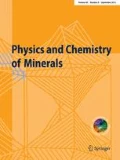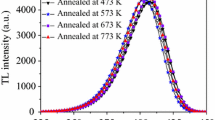Abstract
The red thermoluminescence (RTL) emission of quartz is associated with advantageous features such as high saturation dose and good reproducibility. Previous studies, however, noted inexplicable RTL glow curve shapes with new peaks at large doses (kGy range). Here we present TL spectra of two granitic quartz samples over the additive γ-dose range 0.1–47.9 kGy. While for doses between 0.4 and 1 kGy the TL spectra are dominated by the red emission at 1.95 eV (630 nm), a blue emission at 2.67 eV (465 nm) becomes prominent for higher doses. For one sample, this blue component completely dominates the spectrum for doses > 12.2 kGy with intensity maxima around 200 °C and > 350 °C (heating rate 2 K s−1). The other sample still contains well resolvable red and blue emissions at the largest dose with similar TL peak positions. Signal saturation for the blue emission in the glow curve range 260–300 °C is not yet reached following an additive γ-dose of 47.9 kGy, whereas the red emission generally shows a more subdued signal response for doses > 5–12 kGy. These findings agree qualitatively with additional monochromatic blue and red TL measurements on the same samples. The evolution of supplementary radiofluorescence spectra over the entire γ-dose range is more complex, but suggests that the sensitisation of the blue wavelength region occurs during heating and not during irradiation and through creation of electron traps rather than recombination centres (most likely [AlO4]0 sites). The sharp sensitivity increase at 1 kGy might likewise be related to alkali ion redistribution and/or the removal of non-radiative competitive recombination pathways. While the blue emission still requires thorough investigation, care should be taken when recording RTL using optical filters since significant portions of the registered TL could originate from the blue component entering the RTL transmission window. In practical terms, the dose-dependent change in relative intensities of blue and red TL emissions might help in detecting exposure to high doses.









Similar content being viewed by others
References
Aitken M (1985) Thermoluminescence dating. Academic Press, London
Ames CJH, Cordova CE (2015) Middle and Late Pleistocene landscape evolution at the Druze Marsh Site in northeast Jordan: implications for population continuity and hominin dispersal. Geoarchaeology 30:307–329
Ames CJ, Nowell A, Cordova CE, Pokines JT, Bisson MS (2014) Paleoenvironmental change and settlement dynamics in the Druze Marsh: results of recent excavation at an open-air Paleolithic site. Quat Int 33:60–73
Briceño HO, Schubert C (1990) Geomorphology of the Gran Sabana, Guyana Shield, southeastern Venezuela. Geomorphology 3:125–141
Briceño HO, Schubert C, Paolini J (1990) Table-mountain geology and surficial geochemistry: Chimanta Massif Venezuelan Guyana shield. J S Am Earth Sci 3:179–194
Chalcraft D, Pye K (1984) Humid tropical weathering of quartzite in southeastern Venezuela. Z Geomorph NF 28:321–332
Chawla S, Rao TG, Singhvi AK (1998) Quartz thermoluminescence: dose and dose-rate effects and their implications. Radiat Meas 29:53–63
Chen R, Lawless JL, Pagonis V (2017) Thermoluminescence associated with two-electron traps. Radiat Meas 99:10–17
Doerr SH (1999) Karst-like landforms and hydrology in quartzites of the Venezuelan Guyana shield: pseudokarst or real karst? Z Geomorph NF 43:1–17
Fattahi M, Stokes S (2000) Extending the time range of luminescence dating using red TL (RTL) from volcanic quartz. Radiat Meas 32:479–485
Fattahi M, Stokes S (2003) Dating volcanic and related sediments by luminescence methods: a review. Earth Sci Rev 62:229–264
Friedrich J, Fasoli M, Kreutzer S, Schmidt C (2017) The basic principles of quartz radiofluorescence dynamics in the UV—analytical, numerical and experimental results. J Lumin 192:940–948
Friedrich J, Fasoli M, Kreutzer S, Schmidt C (2018) On the dose rate dependence of radiofluorescence signals of natural quartz. Radiat Meas 111:19–26
Ganzawa Y, Maeda M (2009) 390–410 °C isothermal red thermoluminescence (IRTL) dating of volcanic quartz using the SAR method. Radiat Meas 44:517–522
Guzzo PL, de Souza LBF, Barros VM, Khoury HJ (2017) Spectroscopic account of the point defects related to the sensitization of TL peaks beyond 220 °C in natural quartz. J Lumin 188:118–128
Hashimoto T, Yokosaka K, Habuki H (1987) Emission properties of thermoluminescence from natural quartz-blue and red TL response to absorbed dose. Nucl Tracks Radiat Meas 13:57–66
Hashimoto T, Kojima M, Shirai N, Ichino M (1993) Activation energies from blue- and red-thermoluminescence (TL) of quartz grains and mean lives of trapped electrons related to natural red-TL. Nucl Tracks Radiat Meas 21:217–223
Hunter PG, Spooner NA, Smith BW (2018) Thermoluminescence emission from quartz at 480 nm as a high-dose radiation marker. Radiat Meas 120:143–147
Huntley DJ, Godfrey-Smith DI, Thewalt MLW, Berger GW (1988a) Thermoluminescence spectra of some mineral samples relevant to thermoluminescence dating. J Lumin 39:123–136
Huntley DJ, Godfrey-Smith DI, Thewalt MLW, Prescott JR, Hutton JT (1988b) Some quartz thermoluminescence spectra relevant to thermoluminescence dating. Nucl Tracks Radiat Meas 14:27–33
Itoh N, Stoneham D, Stoneham A (2002) Ionic and electronic processes in quartz: mechanisms of thermoluminescence and optically stimulated luminescence. J Appl Phys 92:5036–5044
Jain M, Duller GAT, Wintle A (2007) Dose response, thermal stability and optical bleaching of the 310 °C isothermal TL signal in quartz. Radiat Meas 42:1285–1293
King GE, Finch A, Robinson R, Hole D (2011) The problem of dating quartz 1: spectroscopic ionoluminescence of dose dependence. Radiat Meas 46:1–9
King GE, Guralnik B, Valla PG, Herman F (2016a) Trapped-charge thermochronometry and thermometry: a status review. Chem Geol 446:3–17
King GE, Herman F, Lambert R, Valla P, Guralnik B (2016b) Multi-OSL-thermochronometry of feldspar. Quat Geochronol 33:76–87
Kolb T, Fuchs M, Zöller L (2016) Deciphering fluvial landscape evolution by luminescence dating of river terrace formation: a case study from Northern Bavaria, Germany. Z Geomorph 60:29–48
Krbetschek MR, Trautmann T (2000) A spectral radioluminescence study for dating and dosimetry. Radiat Meas 32:853–857
Krbetschek MR, Götze J, Dietrich A, Trautmann T (1997) Spectral information from minerals relevant for luminescence dating. Radiat Meas 27:695–748
Kuhn R, Trautmann T, Singhvi AK, Krbetschek MR, Wagner GA, Stolz W (2000) A study of thermoluminescence emission spectra and optical stimulation spectra of quartz from different provenances. Radiat Meas 32:653–657
Lawless JL, Chen R, Lo D, Pagonis V (2005) A model for non-monotonic dose dependence of thermoluminescence (TL). J Phys Condens Matter 17:737–753
Martini M, Meinhardi F, Vedda A (2000) The role of alkali ions in the 190 K TSL peak in quartz. Radiat Meas 32:673–677
Martini M, Fasoli M, Villa I, Guibert P (2012) Radioluminescence of synthetic and natural quartz. Radiat Meas 47:846–850
McKeever SWS (1991) Mechanisms of thermoluminescence production: some problems and a few answers? Nucl Tracks Rad Meas 18:5–12
Miallier D, Faïn J, Sanzelle S, Pilleyre T, Montret M, Soumana S, Falguères C (1994) Attempts at dating pumice deposits around 580 ka by use of red TL and ESR of xenolithic quartz inclusions. Radiat Meas 23:399–404
Montret M, Miallier D, Sanzelle S, Fain J, Pilleyre T, Soumana S (1992) TL dating in the holocene using red TL from quartz. Anc TL 10:33–36
Murray AS, Wintle AG (2000) Application of the single-aliquot regenerative-dose protocol to the 375 °C quartz TL signal. Radiat Meas 32:579–583
Pagonis V, Lawless J, Chen R, Chithambo ML (2011) Analytical expressions for time-resolved optically stimulated luminescence experiments in quartz. J Lumin 131:1827–1835
Pagonis V, Chithambo ML, Chen R, Chruścińska A, Fasoli M, Li SH, Martini M, Ramseyer K (2014) Thermal dependence of luminescence lifetimes and radioluminescence in quartz. J Lumin 145:38–48
Pilleyre T, Montret M, Faïn J, Miallier D, Sanzelle S (1992) Attempts at dating ancient volcanoes using the red TL of quartz. Quat Sci Rev 11:13–17
Plötze M, Wolf D, Krbetschek MR (2012) Gamma-irradiation dependency of EPR and TL-spectra of quartz. In: Götze J, Möckel R (eds) Quartz: deposits, mineralogy and analytics. Springer, Heidelberg, pp 177–190
Reiners PW, Brandon MT (2006) Using thermochronology to understand orogenic erosion. Annu Rev Earth Planet Sci 34:419–466
Rendell HM, Townsend PD, Wood RA, Luff BJ (1994) Thermal treatments and emission spectra of TL from quartz. Radiat Meas 23:441–449
Richter D, Krbetschek M (2006) A new thermoluminescence dating technique for heated flint. Archaeometry 48:695–705
Richter D, Pintaske R, Dornich K, Krbetschek M (2012) A novel beta source design for uniform irradiation in dosimetric applications. Anc TL 30:57–63
Richter D, Richter A, Dornich K (2013) Lexsyg—a new system for luminescence research. Geochronometria 40:220–228
Richter D, Klinger P, Schmidt C, van den Bogaard P, Zöller L (2017) New chronometric age estimates for the context of the Neanderthal from Wannen-Ochtendung (Germany) by TL and argon dating. J Archaeol Sci Rep 14:127–136
Rink WJ, Rendell H, Marseglia EA, Luff BJ, Townsend PD (1993) Thermoluminescence spectra of igneous quartz and hydrothermal vein quartz. Phys Chem Miner 20:353–361
Schilles T, Poolton N, Bulur E, Bøtter-Jensen L, Murray AS, Smith G, Riedi P, Wagner GA (2001) A multi-spectroscopic study of luminescence sensitivity changes in natural quartz induced by high-temperature annealing. J Phys D Appl Phys 34:722–731
Schmidt C, Friedrich J, Zöller L (2015) Thermochronometry using red TL of quartz?—Numerical simulation and observations from in situ drill-hole samples. Radiat Meas 81:98–103
Scholefield RB, Prescott JR (1999) The red thermoluminescence of quartz: 3-D spectral measurements. Radiat Meas 30:83–95
Scholefield RB, Prescott JR, Franklin A, Fox P (1994) Observations on some thermoluminescence emission centres in geological quartz. Radiat Meas 23:409–412
Shimizu N, Mitamura N, Takeuchi A, Hashimoto T (2006) Dependence of radioluminescence on TL-properties in natural quartz. Radiat Meas 41:831–835
Spooner NA, Questiaux DG (2000) Kinetics of red, blue and UV thermoluminescence and optically-stimulated luminescence from quartz. Radiat Meas 32:659–666
Townsend PD (1994) Analysis of TL emission spectra. Radiat Meas 23:341–348
Veronese I, Giussani A, Göksu H, Martini M (2004) The trap parameters of electrons in intermediate energy levels in quartz. Radiat Meas 38:743–746
Weil JA (1984) A review of electron spin spectroscopy and its application to the study of paramagnetic defects in crystalline quartz. Phys Chem Miner 10:149–165
Westaway K, Prescott J (2012) Investigating signal evolution: a comparison of red and UV/blue TL, and UV OSL emissions from the same quartz sample. Radiat Meas 47:909–915
Wintle AG (2008) Fifty years of luminescence dating. Archaeometry 50:276–312
Woda C, Wagner GA (2007) Non-monotonic dose dependence of the Ge- and Ti-centres in quartz. Radiat Meas 42:1441–1452
Woda C, Schilles T, Rieser U, Mangini A, Wagner GA (2002) Point defects and the blue emission in fired quartz at high doses: a comparative luminescence and EPR study. Radiat Prot Dosim 100:261–264
Zöller L, Richter D, Blanchard H, Einwögerer T, Händel M, Neugebauer-Maresch C (2014) Our oldest children: age constraints for the Krems-Wachtberg site obtained from various thermoluminescence dating approaches. Quat Int 351:83–87
Acknowledgements
We acknowledge support of the Oberfrankenstiftung (Projekt “Niedrigst-Temperatur-Thermochronometrie mittels Thermolumineszenz (Thermalbohrung Weißenstadt)”) and thank Johannes Friedrich for technical assistance. Part of this work was supported by a postdoc fellowship of the German Academic Exchange Service (DAAD, ID 57360695). We thank the two anonymous reviewers for their helpful comments.
Author information
Authors and Affiliations
Corresponding author
Additional information
Publisher's Note
Springer Nature remains neutral with regard to jurisdictional claims in published maps and institutional affiliations.
Rights and permissions
About this article
Cite this article
Schmidt, C., Woda, C. Quartz thermoluminescence spectra in the high-dose range. Phys Chem Minerals 46, 861–875 (2019). https://doi.org/10.1007/s00269-019-01046-w
Received:
Accepted:
Published:
Issue Date:
DOI: https://doi.org/10.1007/s00269-019-01046-w




